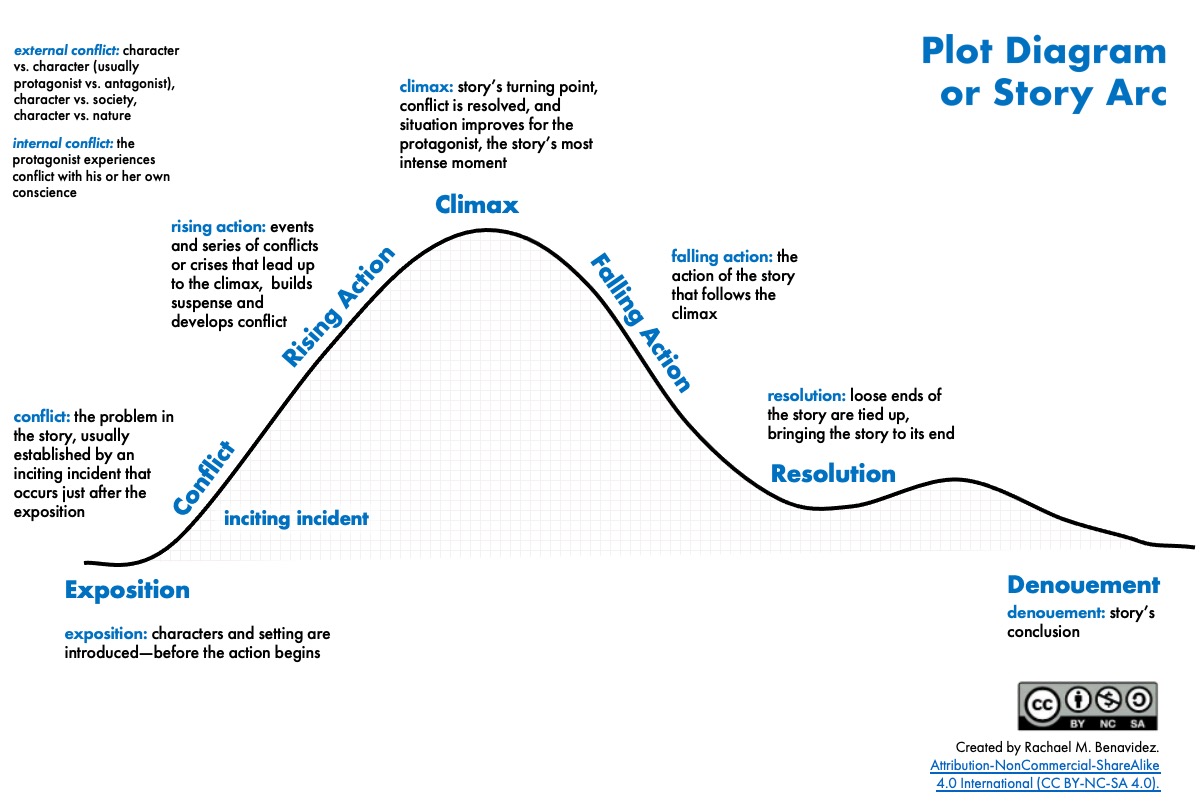Summarizing a Literary Text
A summary of a story presents a critical description of the exhibit that we are analyzing. Close reading allows us to identify the components of a story as we read. In order to summarize a story, we draw on:
- Information about the text using foundational elements and literary elements
- The Plot line or story arc
Foundational Elements
As with any summary, we begin with basic information:
- The title followed by the year originally published in parentheses
- The author’s full name (first and last)
- The genre:
- short story
- novella
- novel
- play
- film
Literary Elements
- Narrator: Who (or what) is telling the story?
- Narration point of view: What is the point of view of the narrator?
- First person: The narrator is both the storyteller and a character in the story.
- Second person (very rare): The reader is telling the story.
- Third person omniscient: The narrator is not a character in the story but can see and tell the actions and thoughts of all of the characters at all times.
- Third person limited: The narrator is not a character in the story but can see and tell the actions and thoughts of some of the characters at all times.
- Panel: The same story is told from different viewpoints.
- Setting: The setting provides the when and where of the story, which, in turn, provides the reader with context for the plot or action of the story.
- When does the story take place? The setting can be the time period in history or even time of day.
- What is the geographical location of the story, which can be a country, city, street, or even a room or seat at a table?
- What is the atmosphere, such as socio-economic norms and status that influence the prevailing mental and emotional climate of the story?
- Characters: Who are the main and secondary characters in the story?
- What type of beings are the characters (human, animal, robot)?
- Who is the protagonist (hero/heroine)? Who is the antagonist (villain)? Keep in mind that many stories don’t have a clear protagonist and antagonist.
- Characterizations: Every character has traits that make them unique. Traits / characterizations allow readers to make predictions about what the character may do or how he or she may react to a situation and to make inferences about why the character reacts in a particular way.
- How does the author express the character’s personality through direct or indirect discourse/dialogue, description, and/or reactions to situations?
- What kind of person is the character?
- Method of characterization: Authors provide insight into the characters directly through speech or indirectly through physical description, action, inner thoughts, and reactions. The characterization also provides insight into how a character transforms (or doesn’t in the plot).
- Flat: Two-dimensional characters with just one or two traits, who are often stereotypes. They help to move the plot quickly, since the audience easily understands them. Example: nerdy professor
- Flat Round: Complex characters who have complex personalities and display unpredictable behaviors. They are usually the antagonists.
- Dynamic: Characters who develop and experience essential change in personality or the way they see the world. They are usually the protagonists.
- Static: Characters who do not change or develop from the way they are initially presented.
- Timeline: We have to consider the elements of time that are evident in the story.
- Chronological / linear time: Begins at the beginning and moves through time to the end.
- Flashback: Begins in the present and goes to the past.
- Circular / anticipatory: Begins in the present, flashes back to the past, and returns to the present at the conclusion.
- Foreshadowing: An indication or indications are provided early in the text that gives clues about what will happen later.
The Plot Line or Story Arc
Our central goal when summarizing a literary work is to describe the narrative plot line or story arc—the events that make up a story.
There are six elements of a plot diagram or traditional story arc, and they often—but not always—occur in a specific order.
|
Beginning |
Middle |
End |
|
Exposition Conflict |
Rising Action Climax |
Falling Action Resolution and Denouement |
- Exposition: The characters and setting are introduced—before the action begins.
- Conflict: The problem in the story, usually established just after the exposition. Characters can experience external and/or internal conflict.
- Rising action: The events and series of conflicts or crises that lead up to the climax, builds suspense and develops conflict.
- Climax: The story’s turning point, conflict is resolved, and situation improves for the protagonist, the story’s most intense moment
- Falling Action: The action of the story that follows the climax
- Resolution and Denouement: The loose ends of the story are tied up, bringing the story to its end (denouement).
The following diagram provides a visual representation of the plot line or story arc.
Reference: Effective Paragraphing, Functions of Sources

